Biden Continues To Lead Democratic Field While Warren Slips Into Second
Joe Biden continues to lead the Democratic field but Elizabeth Warren has slipped into second while Bernie Sanders and Kamala Harris appear to be slipping.
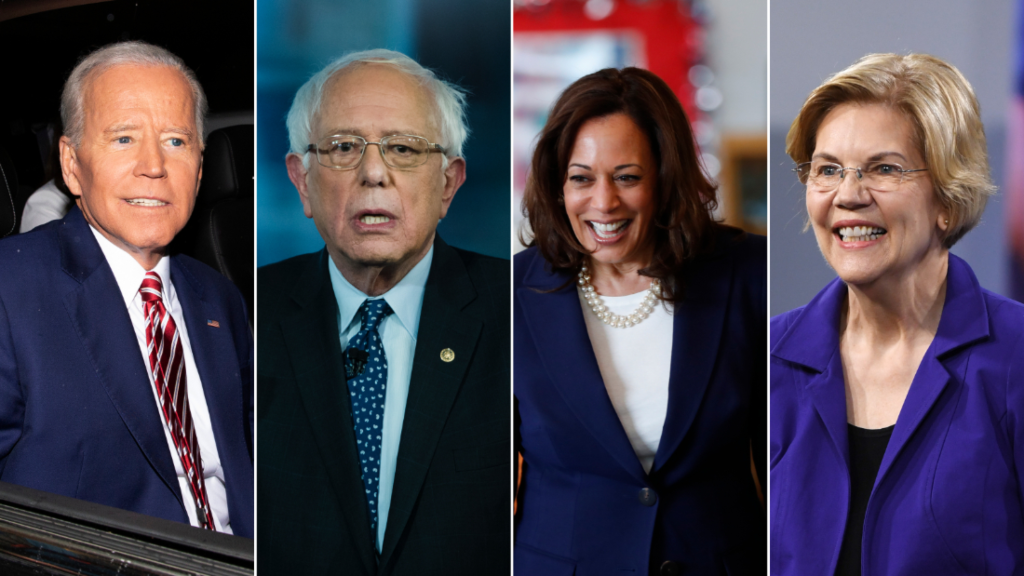
The latest national poll of the race for the Democratic Presidential nomination shows that Joe Biden continues to maintain a healthy lead after the second debate, while Elizabeth Warren seems to be surpassing Senators Sanders and Harris for second place:
In the first major shakeup to the lineup, Elizabeth Warren moves ahead of Bernie Sanders to claim second place behind Joe Biden in the Democratic nomination race. In addition, primary voters sharply divide between embracing former President Obama’s legacy and taking a new path.
A new Fox News Poll finds Biden continues to lead the nomination race with the support of 31 percent of Democratic primary voters. Next is Elizabeth Warren at 20 percent, Bernie Sanders at 10 percent, and Kamala Harris at 8 percent.
Warren’s move up came in steady steps. From March to May she gained 5 points, then 3 more in July, and 8 more in August — for a total 16 percentage-point increase.
During that same time, Sanders dropped 13 points (from 23 percent in March to 10 percent now).
Biden and Harris are both exactly where they were in March.
By a wide 60-36 percent margin, Democratic primary voters prefer a nominee who will “restore the country and get American politics back to normalcy” over one who will “fundamentally change” how Washington works.
They divide sharply, however, when deciding between a candidate who will build on Obama’s legacy (48 percent) and one who will take a new and different approach (47 percent).
Those favoring a new approach go for Warren over Biden by 5 points, while those wanting to build on Obama’s legacy back Biden by 26.
By a 20-point margin, Biden is also preferred over Warren among those who want a nominee who will restore normalcy (39 vs. 19 percent). The vote preference is mixed among those who want to fundamentally change how Washington works: Warren (20 percent), Biden (19 percent), Sanders (18 percent), and Harris (10 percent).
These numbers are, by and large, consistent with other polling that has taken place since we last looked at the national polling roughly two weeks ago:
- The latest poll from The Hill and HarrisX has former Vice-President Biden at 31%, followed by Senator Sanders at 16%, Senator Warren at 10%, and Senator Harris at 7%. Mayor Pete Buttigieg and former Congressman Beto O’Rourke are tied for fourth at 4% and Senator Amy Klobuchar is at 2%. All other candidates are at or under 1%;
- The latest Politico/Morning Consult poll has Biden at 33%, followed by Sanders at 20%, Warren at 14%, and Harris at 9%. Behind Harris, we have Buttigieg at 5%, followed by O’Rourke and Senator Booker tied at 3%, Andrew Yang at 2%, and all other candidates at or below 1%;
- The latest Quinnipiac poll has Biden at 32%, Warren at 20%, Sanders at 14%, and Harris at 7%. Behind Harris, we have Buttigieg at 5% followed by O’Rourke and Booker tied at 2% with all other candidates at or under 1%;
- The latest SurveyUSA poll has Biden at 33% followed by Sanders at 20%, Warren at 19%, Harris at 9%, and Buttigieg at 8%. All other candidates are at or under 1%;
- Finally, there’s the Economist/YouGov poll which has been an outlier in that it has consistently shown a tighter race than other polling. In this poll, Joe Biden leads with 23%. followed by Warren at 20%, Sanders at 16%, and Harris at 8%. Pete Buttigieg is in fifth place at 6%, while Beto O’Rourke sits at 5%, and Cory Booker, Tulsi Gabbard, and Andrew Yang are tied at 2%. All other candidates are at or under 1%.
Looking at the RealClearPolitics numbers, the rise of Elizabeth Warren becomes more apparent:
- Joe Biden —- 30.5%
- Elizabeth Warren — 17.3%
- Bernie Sanders — 16.0%
- Kamala Harris — 8.0%
- Pete Buttigieg — 5.2%
- Beto O’Rourke — 2.8%
- Cory Booker — 2.0%
- Andrew Yang — 1.5%
- Amy Klobuchar — 1.3%
- All other candidates at or under 1%
Here’s the RealClearPolitics chart where the trend for each of the candidates can clearly be seen:
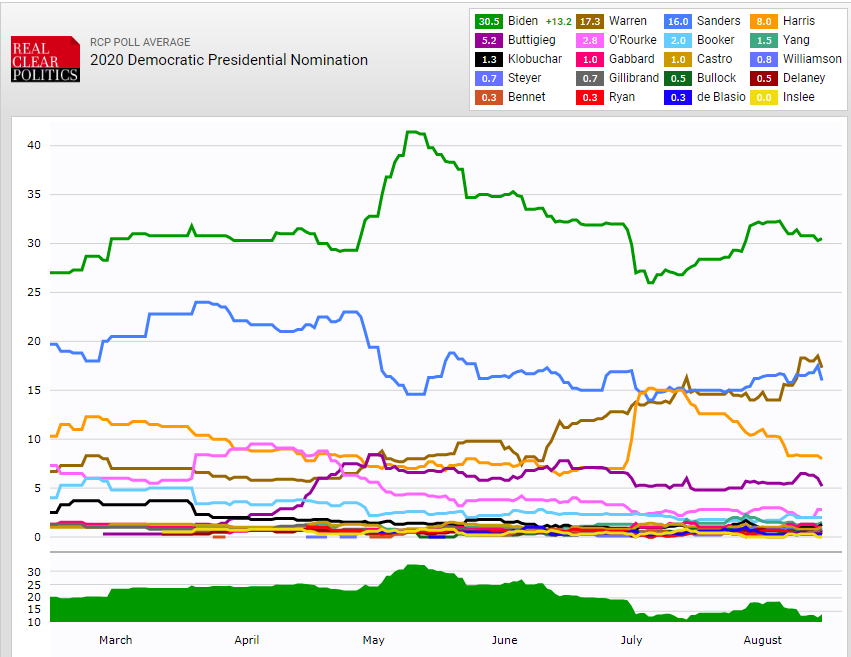
The biggest takeaway here, of course, is the rise of Elizabeth Warren to the point where, at least for the moment, she has passed Bernie Sanders for second place in several of the polls and the RCP average. Conversely, both Senator Sanders and Senator Harris seem to be fading somewhat. In Sanders case, this appears to be due to the fact that he has been forced to compete with Warren, Harris, and other candidates for the progressive voters that he had virtually all to himself in 2016. In the case of Senator Harris, it seems that the bump she got from the first debate had faded significantly and while this doesn’t mean her campaign is over, it is a sign that she is in danger of being eclipsed by Senator Warren to the point where she might not be able to catch up. Pete Buttigieg, meanwhile, stays in the same position he’s had for months now as something of a bridge between the frontrunners and the rest of the pack. If he’s going to make a move, the coming fall debates would seem to be his best chance of making a breakthrough. Just outside the bottom of the field, meanwhile, we have candidates like Beto O’Rourke, Cory Booker, Andrew Yang, and Amy Klobuchar. The likelihood that any of these candidates will breakthrough becomes increasingly unlikely by the day, of course, and they have a very short period of time within which to try to have an impact. Finally, as for those candidates polling at or below 1% and showing no signs of movement ought to just look at reality and realize it’s time to give up the ghost already.
Obviously, there’s still a lot of time left in the race for the Democratic nomination. The first votes won’t be cast for another 169 days and that will be just the beginning of a process that could last for another four months before we know who the nominee will be. That being said, the early trends are clear and those early trends are going to drive things like media attention and donor dollars. There could be a few shake-ups along the way but for now, it looks like we’ve got a four-person race with Biden, Warren, Sanders, and Harris at the top and Pete Buttigieg pulling up the rear but with enough support to remain viable for some time to come.

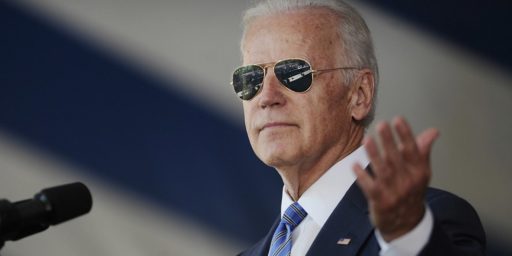
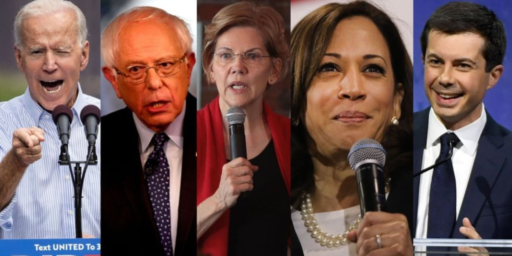
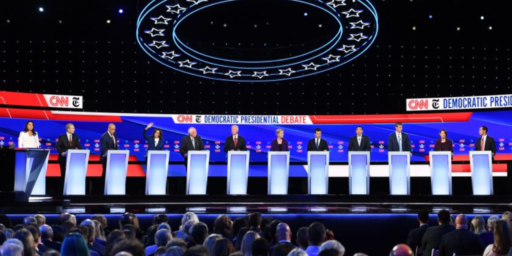
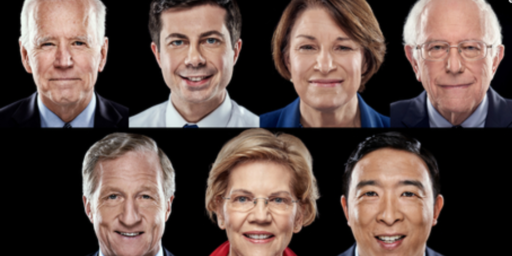
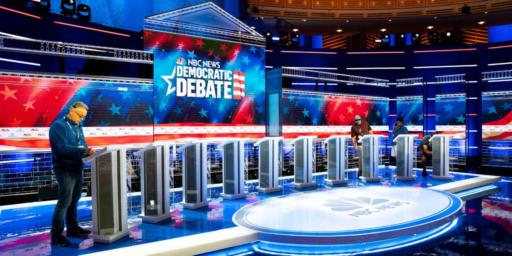
Just keep your version of Corbyn (Sanders) out. Leftist purist posturers are grossly ineffective and losers. Had only Labour not been so idiotic in 2015 and let the Left activists take over.
This doesn’t surprise me, but I remain concerned about Biden’s tendency to commit unforced errors. Having one old guy vs. another old guy on the ticket isn’t really compelling and I do also worry about turnout.
I’m a Buttigieg fan, and have a somewhat different view of his numbers. I’m glad he’s continuing to do well (being closer to the #4 than the #6 on the list), and he had a solid week in Iowa. I’d be happy with a solid showing in either (or both) IA and NH, to get him on the list for either VP slot or a cabinet position. I don’t know when the filing deadline is for IN governor, but that could be an option too. He’s young and if he doesn’t make it to the top slot this time, I’d very much like to see him positioned to come back at this at another point in the future.
Polls that have broken down the demographics of different voters have found surprisingly little overlap between the Warren and Sanders crowd. Sanders supporters are primarily lower-income, less educated, and likelier to be young or male compared to Warren supporters who are predominantly older, better educated, and more often female. Furthermore, the top “second choice” for Sanders supporters is still Biden, and vice versa.
The conventional categories that you and I would sort the candidates into–progressive, centrist, etc.–are not necessarily the ones motivating voters at this point. (Indeed, it wasn’t in 2016 either, when Sanders became a proxy for voters who disliked Clinton, which may help explain why a substantial chunk of his 2016 supporters described themselves as moderate or conservative.) And we’re early enough in the process that name recognition is still playing an outsize role.
Again I note how impressed I am by Warren’s trendline. One runs a campaign, I presume, in order to persuade voters – to change their minds – and she is the only one who seems to be doing that in a way that sticks. I think it must be the town halls I’ve read about, but I’m sure it’s also her approach – I’m going to figure out what works, and stick to it.
I have a one word explanation for the rise of Warren: optimism.
Sanders rants and condemns. Biden offers a nostalgic return to ‘before’. Harris reads as a triangulator. And Warren just keeps smiling and saying, “I have a plan for that.”
Trump is all fear, all the time. Warren is all hope. If that’s the race in 2020 it’ll be an interesting psychological test. Are we still an optimistic country?
@michael reynolds: “Trump is all fear, all the time. Warren is all hope.”
I think this sells Warren a little short. Yes, she’s optimistic, but she doesn’t only offer hope and change, she can draw a map showing how we’ll get there. It’s a strategy that a lot of experts seemed to laugh at, as it assumed that voters were interested in details and smart enough to follow them — but it seems to be working.
Of all the candidates, so far she is most clearly the anti-Trump…
Is it possible that the Economist/YouGov poll is composed of the type of people who can read and understand The Economist? That would certainly account for the polls outlier nature. It would also be a mistake in poll selection in that it would clearly be unrepresentative of the American populace, let alone the actual electorate. But it would account for the results it shows.
You needn’t worry…Sanders, who isn’t even a Democrat, won’t get the Democratic nomination…
It’ll be nice to have an intelligent president again…
@Just nutha ignint crackerr: Kind of like that Literary Digest poll in 1936 that showed Alf Landon winning in a landslide. Its sample came mostly from magazine subscribers, club members, and the minority of Americans who owned telephones–which skewed richer and more Republican.
@Just nutha ignint crackerr:
No, but it is an internet poll which could explain why it looks different than Quinnipiac Survey USA, and the Fox poll. On the other hand, Morning Consult is also an internet poll, so maybe not.
It’s impossible to imagine any circumstances under which Sanders could recover from his gradual slide to win the nomination. If he was going to win, it would have been by entering as the front-runner and gradually gathering momentum. He didn’t even come close.
If he truly has the interests of his sometime-party and his nation at heart, he will withdraw from the race, endorse Warren and campaign for her with energy and enthusiasm. However I don’t expect him to do any such thing. If he persists in a losing campaign to the bitter end, clinging to his c. 15% following and fragmenting the not-Biden vote, he’ll go down in history as the man who twice put personal vanity over the national interest to help elect Trump.